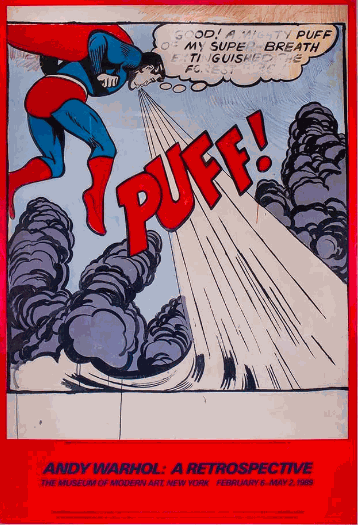Andy Warhol
Early Life and Education
Warhol was the youngest of three sons born to Slovakian immigrant parents. He showed an early interest in art and was frequently bedridden with illness during his childhood, which led him to engage in drawing and listening to the radio. Warhol attended Schenley High School and later studied commercial art at the Carnegie Institute of Technology (now Carnegie Mellon University), graduating in 1949 with a degree in pictorial design.
Move to New York and Commercial Art
In 1949, Warhol moved to New York City to pursue a career as a commercial artist. He quickly gained success with his whimsical, blotted-line illustrations for major clients, including Vogue, Harper's Bazaar, and Glamour magazine. His unique style and innovative techniques, such as using rubber stamps and incorporating everyday objects, set him apart in the commercial art world.
Emergence of Pop Art
In the early 1960s, Warhol transitioned from commercial art to fine art, becoming a central figure in the emerging Pop Art movement. He began creating works that reflected and critiqued consumer culture and mass media. His iconic "Campbell's Soup Cans" (1962) series, featuring 32 canvases each depicting a different variety of soup, epitomized this approach, blurring the lines between high art and commercial imagery.
Major Works and Themes
Warhol's oeuvre is characterized by its exploration of consumerism, celebrity, and the commodification of art. His silkscreen portraits of celebrities such as Marilyn Monroe, Elvis Presley, and Elizabeth Taylor are among his most famous works. These portraits, like "Marilyn Diptych" (1962), used repetition and bright colors to both celebrate and critique the cult of celebrity.
Another significant work is "Brillo Boxes" (1964), where Warhol replicated supermarket Brillo soap pad boxes, challenging the art world's definitions of originality and value.
The Factory and Multimedia Projects
In 1962, Warhol established his studio, known as The Factory, which became a hub of creativity and social activity. The Factory attracted a diverse group of artists, musicians, writers, and celebrities, fostering collaboration and experimentation. Warhol produced a wide range of works here, including his famous "Silver Car Crash (Double Disaster)" (1963) and the "Death and Disaster" series, which confronted themes of mortality and tragedy.
Warhol also ventured into filmmaking, creating avant-garde films such as "Sleep" (1963), "Empire" (1964), and "Chelsea Girls" (1966). His films often featured non-traditional narratives and starred his eclectic group of friends and Factory regulars.
Personal Life and Public Persona
Warhol's public persona was as carefully crafted as his art. Known for his distinctive silver wigs, enigmatic demeanor, and pithy sayings like "In the future, everyone will be world-famous for 15 minutes," Warhol became a celebrity in his own right. Despite his public image, he was a deeply private person, and his work often reflected his personal anxieties and obsessions.
Later Career and Legacy
In the 1970s and 1980s, Warhol continued to innovate and expand his artistic practice. He explored new techniques, such as oxidation paintings, and returned to hand-painting. He also collaborated with younger artists like Jean-Michel Basquiat and Keith Haring, bridging generational gaps in the art world.
Warhol's influence extends far beyond his lifetime. He died on February 22, 1987, following complications from gallbladder surgery. His work continues to be celebrated and studied, with major retrospectives and exhibitions at prestigious institutions such as the Museum of Modern Art in New York and the Tate Modern in London.



